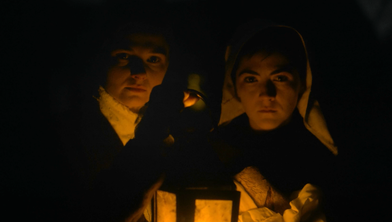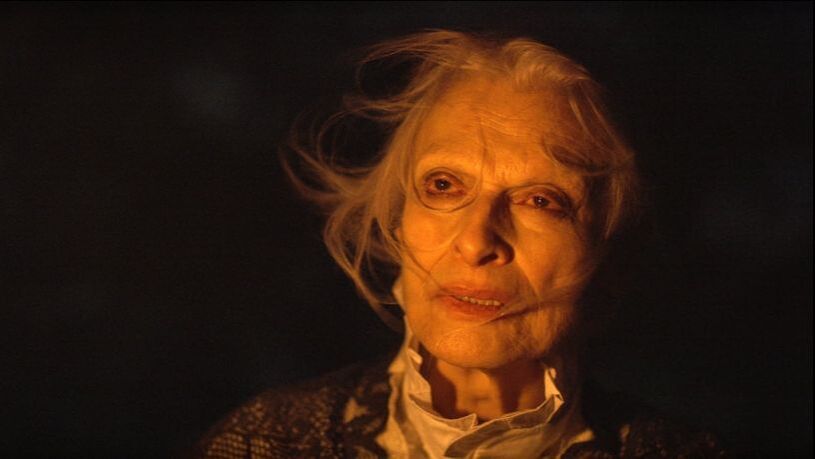 “Fear and weakness keep us here…” …Fear weighs us down. Keeps us in place. Sometimes not by our own hand, but through the fear of others over who or what we are in their eyes. In writer/director Edoardo Vitaletti’s debut feature, The Last Thing Mary Saw, which just premiered at the Fantasia Film Festival, the film gets deep down into the ways in which fear makes prisoners of us all. Set in the winter of 1843, we meet Mary (Stefanie Scott), a young woman being questioned over the death of her family’s matriarch (Judith Roberts). She takes us back before the events which she witnessed, telling a story of her love affair with housemaid Eleanor (Isabelle Fuhrman), the harsh reaction from her deeply religious (and ignorant) family, and the horrors which fear of the unknown or the misunderstood can create. To put it simply: It’s an age-old tale of religious hypocrites preaching faith and acceptance while doing everything but in the face of Mary’s queerness. Naturally, it’s ripe with tension and moments that range between difficult, frustrating or downright infuriating to watch. The Last Thing Mary Saw is a grim film. I know, shocker. Opening with a spooky interrogation scene which sees Mary blindfolded, blood pouring down from her eyes, and Scott’s too-calm presence setting the viewer and everyone else in the scene on edge, Vitaletti’s film latches onto your spine like The Tingler and sends consistent cold shivers through the body for the remaining ninety minutes. This isn’t a film that will have you screaming. Instead it creeps and crawls with a blistering tension between Mary and her family, and the inevitability of something awful. It’s like death in that way. We can see it coming, and the horror is in not being able to do anything about it. Vitaletti presents a world that reeks of death and something sinister heading the family’s way. Cinematographer David Kruta’s dim color palette makes the land which the family lives on and their home seem entirely lifeless. Outside of rare, warm moments in which Mary and Eleanor are given the peace to be together, The Last Thing Mary Saw drips in cold greys and an unfathomable blackness. They represent the only “light” in the film, whereas everything else is withered and dreary. The world in which these two live is not welcoming to them, and Vitaletti lets us feel that through imagery equivalent to a cold shoulder. It makes sense that the film is set during winter, because The Last Thing Mary Saw is an almost entirely joyless experience. Which I suppose is what you get when you live with backward thinking religious nuts who think just about anything that makes you smile is a sin. And if you’re a happy woman, well, you might as well be a witch. The Last Thing Mary Saw is first and foremost a love story steeped in psychological horror dealing with what that love means for our protagonists. Fuhrman and Scott share a sweet chemistry, with raw performances in which Fuhrman is particularly fierce, calling back to when many of us first began to know her as Esther in Orphan. The Last Thing Mary Saw is told like a dark fairytale, exhibiting storybook qualities that walk the line between reality and supernatural. If you enjoyed Fear Street 1666, then you need to see The Last Thing Mary Saw. Both films are recent examples that deal with queer characters forced to face society’s misguided fears towards them, and both present that horror in a way that resonates long after the credits roll. Many of Mary’s family members don’t stand out much except for her brother, Matthew (Elijah Rayman), and, intentional or not, that works because with everyone’s personality revolving around God, they don’t have much of a personality at all. Look no further for proof than their zombie-like prayers and a lengthy funeral scene in which no one speaks. Which makes them more frightening. The most chilling thing about The Last Thing Mary Saw isn’t composer Keegan DeWitt’s highly effective, creaking and groaning score, or the occasional dreamlike, haunting moments that casually insert the supernatural into the story, but it’s the voyeuristic way in which Mary and Eleanor are observed. Every touch between the two, every glance or shared word, is interrupted by someone watching. Sometimes obvious, sometimes watching them through slits in a wall or a door. Those surrounding the two women look at them with a blend of hatred, disgust and curiosity, the combination of which is extremely unsettling. Especially combined with the treatment of the women. Most of the family may not stand out much, but Judith Roberts as the Matriarch is the exception. Roberts played creepy old ghost Mary Shaw in Dead Silence, and I’m convinced that no one does evil old woman better than Roberts. Time and again, Roberts completely steals the scene with an unnerving presence that gets under the skin, and a snake-like delivery in which her words feel more like an evil hiss. She is the one in charge of “curing” the girls, and she gives them the ultimate Saint Maud treatment. But whereas Maud enjoyed the pain, Eleanor and Mary do not, nor do they deserve it. Outside of some grisly effects work, what the two go through is more difficult to watch on principle than it is visually. Vitaletti tosses in queasy effects here and there, but the focus is more psychological horror, centered on the cruelty of religious bigots instead of the torture itself. Look no further than Eleanor forced to kneel on savaged knees in the corner while the rest of the family eats dinner and you’ll understand what I mean. While it doesn’t do much to lift itself above traditional tropes or other stories like it that have come before, The Last Thing Mary Saw is a well-crafted commentary on religion and the ways in which fear holds us hostage. It probably won’t terrify you, but a tense atmosphere and some scene-stealing performances—including an uncomfortable turn from Rory Culkin—make this an eerie shocker well worth the watch. By Matt Konopka
0 Comments
Leave a Reply. |
Archives
March 2023
|


 RSS Feed
RSS Feed